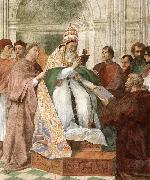|
|
|
|
|
RAFFAELLO Sanzio
|
|
Gregory_IX_Approving_the_Decretals
|
|
|
|
|
|
|
|

|
|
Click to Enlarge
|
| RAFFAELLO_Sanzio
|
Gregory IX Approving the Decretals
new21/RAFFAELLO Sanzio-676874.jpg
|
|
|
|
|
|
| 1511 Fresco, width at base 220 cm Stanza della Segnatura, Palazzi Pontifici, Vatican This scene is based on a dedication picture of the kind often found in manuscript illumination. What is unusual is that Pope Julius II allowed himself to be portrayed as Pope Gregory IX. His beard helps the dating of the fresco since it is known that after the autumn of 1511 he never shaved again. Cardinal Giovanni de' Medici, later to be Leo X, is standing on the pope's far left.Artist:RAFFAELLO Sanzio Title: Gregory IX Approving the Decretals Painted in 1501-1550 , Italian - - painting : religious |
|
|
Italian High Renaissance Painter, 1483-1520
Italian painter and architect. As a member of Perugino's workshop, he established his mastery by 17 and began receiving important commissions. In 1504 he moved to Florence, where he executed many of his famous Madonnas; his unity of composition and suppression of inessentials is evident in The Madonna of the Goldfinch (c. 1506). Though influenced by Leonardo da Vinci's chiaroscuro and sfumato, his figure types were his own creation, with round, gentle faces that reveal human sentiments raised to a sublime serenity. In 1508 he was summoned to Rome to decorate a suite of papal chambers in the Vatican. The frescoes in the Stanza della Segnatura are probably his greatest work; the most famous, The School of Athens (1510 C 11), is a complex and magnificently ordered allegory of secular knowledge showing Greek philosophers in an architectural setting. The Madonnas he painted in Rome show him turning away from his earlier work's serenity to emphasize movement and grandeur, partly under Michelangelo's High Renaissance influence. The Sistine Madonna (1513) shows the richness of colour and new boldness of compositional invention typical of his Roman period. He became the most important portraitist in Rome, designed 10 large tapestries to hang in the Sistine Chapel, designed a church and a chapel, assumed the direction of work on St. Peter's Basilica at the death of Donato Bramante,
|
|
|
|
|
|
|